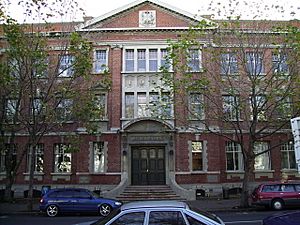University of Otago Dunedin School of Medicine facts for kids
The Dunedin School of Medicine is a special part of the University of Otago in Dunedin, New Zealand. It's where students learn to become doctors.
Students first complete a tough "Health Sciences First Year" program. If they do well, or if they already have a university degree, they can join the medical school. For their second and third years, students study medicine right here in Dunedin.
For their fourth, fifth, and sixth years, students can choose where to continue their studies. They can stay at the Dunedin School of Medicine. Or, they can go to the medical schools in Christchurch or Wellington, which are also part of the University of Otago.
Contents
History of Medical Training
The Otago Medical School first opened its doors in 1875. Back then, students only studied for two years in New Zealand. They had to finish their training overseas.
In 1887, something important happened. The first doctor who had completed all their training only at Otago graduated. By 1891, the medical school officially became the "Faculty of Medicine." At first, medical training took only four years. But in 1920, it was made longer, to six years.
From 1924, students could complete their final year of training in hospitals in other cities. These included Auckland, Christchurch, and Wellington, as well as Dunedin. In 1938, smaller medical branches were set up in these other cities.
Otago's connection with Auckland ended in 1968. This was when the University of Auckland School of Medicine opened its own medical school. The branches in Christchurch and Wellington became full "clinical" schools in 1973 and 1977. These are now known as the University of Otago, Christchurch and the University of Otago, Wellington.
Women in Medicine
Women were not allowed to study medicine until 1891. That year, Emily Siedeberg became the very first female medical student. This was a big step forward!
Between 1896 and 1924, 50 women graduated as doctors from Otago. By 1949, a total of 200 women had earned their medical degrees. Here are some of the early women graduates:
- 1896: Emily Siedeberg
- 1897: Margaret Cruickshank
- 1900: Constance Frost, Daisy Platts-Mills, Alice Horsley
- 1903: Eleanor Baker McLaglan
- 1906: Ada Paterson
- 1916: Doris Gordon
- 1918: Marion King Bennie Cameron
- 1921: Moana Gow, Eva Hill, Sylvia Chapman
- 1922: Muriel Bell
- 1923: Eily Elaine Gurr, Kathleen Todd
- 1924: Mary Champtaloup
- 1925: Cecily Pickerill, Helen Deem
- 1926: Nina Muir, Theodora Hall, Felicia Walmsley
- 1929: Kathleen Pih–Chang
What is the Dunedin School of Medicine?
The Dunedin School of Medicine is one of eight main groups within the University of Otago's Health Sciences Division. This division focuses on all kinds of health-related studies.
Other schools and faculties in this division include:
- The Otago Medical School (where the main medical program starts)
- The School of Biomedical Sciences (which studies how the body works)
- The Faculty of Dentistry (for future dentists)
- The School of Pharmacy (for future pharmacists)
- The School of Physiotherapy (for future physiotherapists)
- The University of Otago, Christchurch (another medical school campus)
- The University of Otago, Wellington (another medical school campus)
Departments and Studies
The Dunedin School of Medicine has eight main academic departments. Each department focuses on a different area of medicine:
- Bioethics: This department studies the right and wrong ways to use medical knowledge.
- General Practice and Rural Health: This focuses on doctors who work in local communities and in the countryside.
- Medicine: This covers general medical care.
- Pathology: This department studies diseases and how they affect the body.
- Preventive and Social Medicine: This looks at how to stop people from getting sick and how health affects communities.
- Psychological Medicine: This deals with mental health.
- Surgical Sciences: This focuses on operations and surgery.
- Women's and Children's Health: This department specializes in the health of mothers, babies, and children.
Most of these departments have smaller sections that focus on even more specific topics. There is also a Dean's Department, which handles the school's administration.
Important Buildings
Most of the Dunedin Medical School is located in a group of buildings near the main University of Otago Campus. These buildings are close to the Dunedin Hospital. They are found between George Street, Hanover Street, Cumberland Street, and Frederick Street.
Some of the key buildings include:
- The Hercus Building: Home to the Department of Pathology.
- The Adams Building: Where the Department of Preventive and Social Medicine is located.
- The Fraser Building: Used by the Department of Psychological Medicine.
Other parts of the school are inside the Dunedin Hospital itself. This includes the Colquhoun and Barnett lecture theatres, where students attend classes. The Dean's Department and the Departments of Medicine, Surgical Sciences, and Women's and Children's Health are also in the hospital. The Department of General Practice and Rural Health is at 55 Hanover Street. The Bioethics Centre is located at 71 Frederick Street.
Two very old and important buildings are the Scott and Lindo Ferguson Buildings. They are near the Hercus and Adams buildings. Both are recognized for their historical importance by Heritage New Zealand.
The Scott Building was built during the First World War. It is now used by the School of Biomedical Sciences. The Lindo Ferguson Building is a grand building made of Oamaru Stone and brick. It was built in 1927. This building is also used by the School of Biomedical Sciences. It was named after Sir Lindo Ferguson, who was the Dean of the Otago Medical School from 1914 to 1937.


